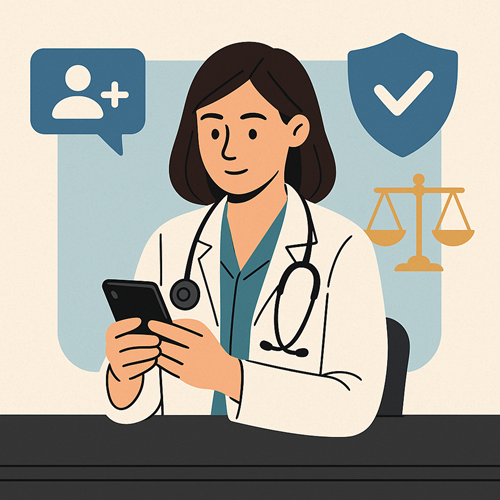Ethical and legal aspects of doctors’ activities on social media: A literature review
Abstract
Introduction: Social media has become an essential communication platform influencing medical professionalism. For doctors, it serves as a tool for education, health promotion, and professional networking. However, unregulated use poses legal and ethical challenges, particularly concerning confidentiality and professionalism. This study explores the legal and ethical implications of doctors’ activities on social media in Indonesia.
Methods: This research employs a normative legal and literature review approach. Sources were obtained from Google Scholar, PubMed, ScienceDirect, Garuda, and Sinta, using keywords such as doctor, social media, ethics, and health law. Articles published between 2020 and 2025 were selected based on relevance to legal and ethical aspects of medical social media use.
Results: Findings indicate that while social media enhances accessibility to health information, education, and patient engagement, it also introduces risks of privacy breaches, misinformation, and blurred doctor–patient boundaries. Indonesian regulations, such as Law No. 11/2008 (ITE Law) and Law No. 17/2023 (Health Law), partially address these issues, but no specific regulation governs doctors’ digital conduct. A comparative analysis with international guidelines, such as those of the General Medical Council (UK), underscores the need for clearer national standards. Ethical principles in the Indonesian Medical Code of Ethics (KODEKI) must guide doctors’ online presence. Strengthened digital professionalism, legal clarity, and continuous education are crucial.
Conclusion: Doctors’ responsible use of social media can enhance public health communication. However, comprehensive legal frameworks and ethical awareness are vital to safeguard patient rights and uphold medical professionalism in the digital era.
Downloads
References
Bero, L. et al. (2025) ‘Ethical, legal, and social issues related to ingestible, implantable electronic devices and mRNA delivery devices’, Device, p. 100841. doi: https://doi.org/10.1016/j.device.2025.100841.
Brenner, E. et al. (2024) ‘The legal and ethical framework governing body donation in Europe – 2nd update on current practice’, Annals of Anatomy - Anatomischer Anzeiger, 252, p. 152195. doi: https://doi.org/10.1016/j.aanat.2023.152195.
Brivot, M., Paquette, S. and Huxley, Z. (2025) ‘Navigating the spectrum of aggressiveness: Social dynamics and anxieties in tax planning’, Accounting, Organizations and Society, 114, p. 101589. doi: https://doi.org/10.1016/j.aos.2025.101589.
Bulut, B. and Kar, H. (2025) ‘Sexual violence via social media’, Journal of Forensic and Legal Medicine, 114, p. 102908. doi: https://doi.org/10.1016/j.jflm.2025.102908.
Calvaresi, D. et al. (2025) ‘Computational persuasion technologies, explainability, and ethical-legal implications: A systematic literature review’, Computers in Human Behavior Reports, 17, p. 100577. doi: https://doi.org/10.1016/j.chbr.2024.100577.
Capulli, E. et al. (2025) ‘Ethical and legal implications of health monitoring wearable devices: A scoping review’, Social Science & Medicine, 370, p. 117685. doi: https://doi.org/10.1016/j.socscimed.2025.117685.
Chimukuche, R. S. et al. (2024) ‘Evaluation of Drug and Herbal Medicinal Promotions on Social Media During the COVID-19 Pandemic in Relation to World Health Organization Ethical Criteria and South African Health Products Regulatory Authority Guidelines in South Africa: Cross-Sectional Content Analysis’, Online Journal of Public Health Informatics, 16. doi: https://doi.org/10.2196/58378.
Choi, S. et al. (2025) ‘Ethical, legal, social, and cultural implications of the non-clinical use of transcranial direct current stimulation (tDCS) in Korea and Japan’, Neuroscience Research, 219, p. 104951. doi: https://doi.org/10.1016/j.neures.2025.104951.
Crawford, A. D. et al. (2025) ‘A reproductive justice investigation of utilizing digital interventions among underserved populations with criminal legal system supervision: Policy brief’, Nursing Outlook, 73(2), p. 102349. doi: https://doi.org/10.1016/j.outlook.2025.102349.
Farooq, Minaam et al. (2024) ‘Social media as a clinical, educational and networking tool for neurosurgeons: A systematic review of literature’, Journal of Clinical Neuroscience, 126, pp. 256–264. doi: https://doi.org/10.1016/j.jocn.2024.06.025.
Grijalba, M. et al. (2024) ‘Organization of legal and forensic medicine in Spain’, Spanish Journal of Legal Medicine, 50(4), pp. 155–163. doi: https://doi.org/10.1016/j.remle.2024.11.003.
Irawati, I., Kistan, K. and Basri, M. (2023) ‘The Effect of the Duration of Social Media Use on the Incidence of Student Insomnia’, Jurnal Ilmiah Kesehatan Sandi Husada, 12(1), pp. 176–182. doi: https://dx.doi.org/10.35816/jiskh.v12i1.942.
Jandu, S. and Carey, J. L. (2025) ‘Exploring Social Media Use Among Medical Students Applying for Residency Training: Cross-Sectional Survey Study’, JMIR Medical Education, 11. doi: https://doi.org/10.2196/59417.
Kohanová, D. et al. (2025) ‘Social media behaviour and patterns of use among nursing students: A systematized review’, Nurse Education in Practice, 83, p. 104277. doi: https://doi.org/10.1016/j.nepr.2025.104277.
Lee, J. Y.-H., Panteli, N. and Lin, J. C.-Y. (2025) ‘Managing medical knowledge flow: Physicians’ social media actualisation practices’, Social Science & Medicine, 365, p. 117534. doi: https://doi.org/10.1016/j.socscimed.2024.117534.
Low, K. J. et al. (2025) ‘Parental Use of Social Media and the Internet in the Context of Their Child’s Genetic Neurodevelopmental Disorder: Mixed Methods Study Nested in the GenROC Cohort Study’, JMIR Pediatrics and Parenting, 8. doi: https://doi.org/10.2196/76526.
Lyytinen, E. (2025) ‘Legal geographies of deportability – Entanglements of power between nomospheric guardians, technicians, and figures’, Political Geography, 119, p. 103333. doi: https://doi.org/10.1016/j.polgeo.2025.103333.
Omidvar, M., Ghasemi, V. and Frau, M. (2024) ‘Exploring the impact of environmental dimension in corporate social responsibility on restaurants’ customer retention’, British Food Journal, 126(12), pp. 4375–4395. doi: https://doi.org/10.1108/BFJ-01-2024-0030.
Reinhart, E. (2025) ‘On medical ideology and the production of docile doctors: The politics of care in an age of authoritarianism’, Social Science & Medicine, 383, p. 118428. doi: https://doi.org/10.1016/j.socscimed.2025.118428.
Romero-Moreno, F. (2025) ‘Deepfake detection in generative AI: A legal framework proposal to protect human rights’, Computer Law & Security Review, 58, p. 106162. doi: https://doi.org/10.1016/j.clsr.2025.106162.
Sánchez-Santos, R. and Cano-Valderrama, O. (2024) ‘Social media and surgery’, Cirugía Española (English Edition), 102, pp. S72–S77. doi: https://doi.org/10.1016/j.cireng.2023.11.010.
Sathianathan, S., Mhd Ali, A. and Chong, W. W. (2025) ‘How the General Public Navigates Health Misinformation on Social Media: Qualitative Study of Identification and Response Approaches’, JMIR Infodemiology, 5. doi: https://doi.org/10.2196/67464.
Sievi, L. and Pawelec, M. (2025). (How) Should security authorities counter false information on social media in crises? A democracy-theoretical and ethical reflection’, International Journal of Disaster Risk Reduction, 116, p. 105093. doi: https://doi.org/10.1016/j.ijdrr.2024.105093.
Sun, H., Chen, Y. and Zhang, Y. (2025) ‘Who is to blame for AV crashes? Public perceptions of blame attribution using text mining based on social media, Computers in Human Behavior, 168, p. 108627. doi: https://doi.org/10.1016/j.chb.2025.108627.
Suprapto, S. and Ihsan Kamaruddin, M. (2025) ‘Integration of digital technology by health analysts in health information systems: Systematic Review’, Journal Interdisciplinary Health, 1(1), pp. 34–43. doi: https://doi.org/10.61099/jih.v1i1.105.
Sydorenko, A. Y., Kubanskyi, S. and Kiel, L. (2025) ‘Support needs of Ukrainian healthcare workers during wartime: A study on trust, legal security, and labor union involvement’, Public Health, 238, pp. 298–302. doi: https://doi.org/10.1016/j.puhe.2024.12.017.
Tunga, T. L. E. (2022) ‘Gangguan Makan pada Remaja Dipengaruhi Oleh Media Sosial Melalui Citra Tubuh Negatif’, Jurnal Ilmiah Kesehatan Sandi Husada, 11(1), pp. 1–9. doi: https://dx.doi.org/10.35816/jiskh.v11i1.684.
Wijayanti, Y. T. et al. (2025) ‘Perception of Nursing Students on Clinical Teaching and Learning of Public Health Nurses: A Descriptive Qualitative Approach’, Malaysian Journal of Nursing, 16(04), pp. 142–151. doi: https://doi.org/10.31674/mjn.2025.v16i04.014.
Zhang, W. et al. (2025) ‘Examining healthcare workers’ engagement with social media-based health education: Influencing factors, challenges, and future directions’, Patient Education and Counseling, 131, p. 108577. doi: https://doi.org/10.1016/j.pec.2024.108577.

Copyright (c) 2025 I Wayan Tunjung, I Made Putra Biantara

This work is licensed under a Creative Commons Attribution 4.0 International License.




2.png)
1.png)
1.png)










